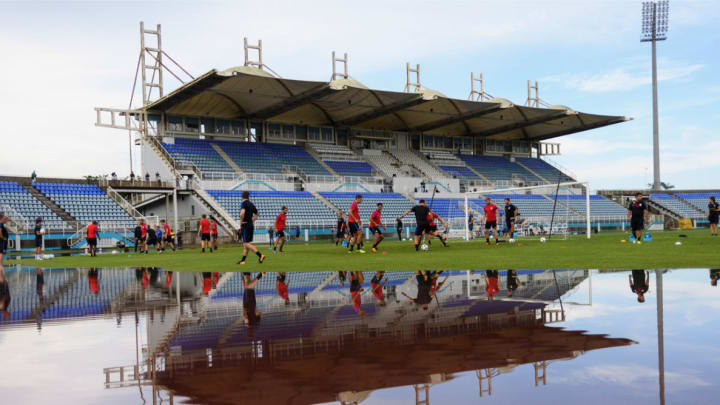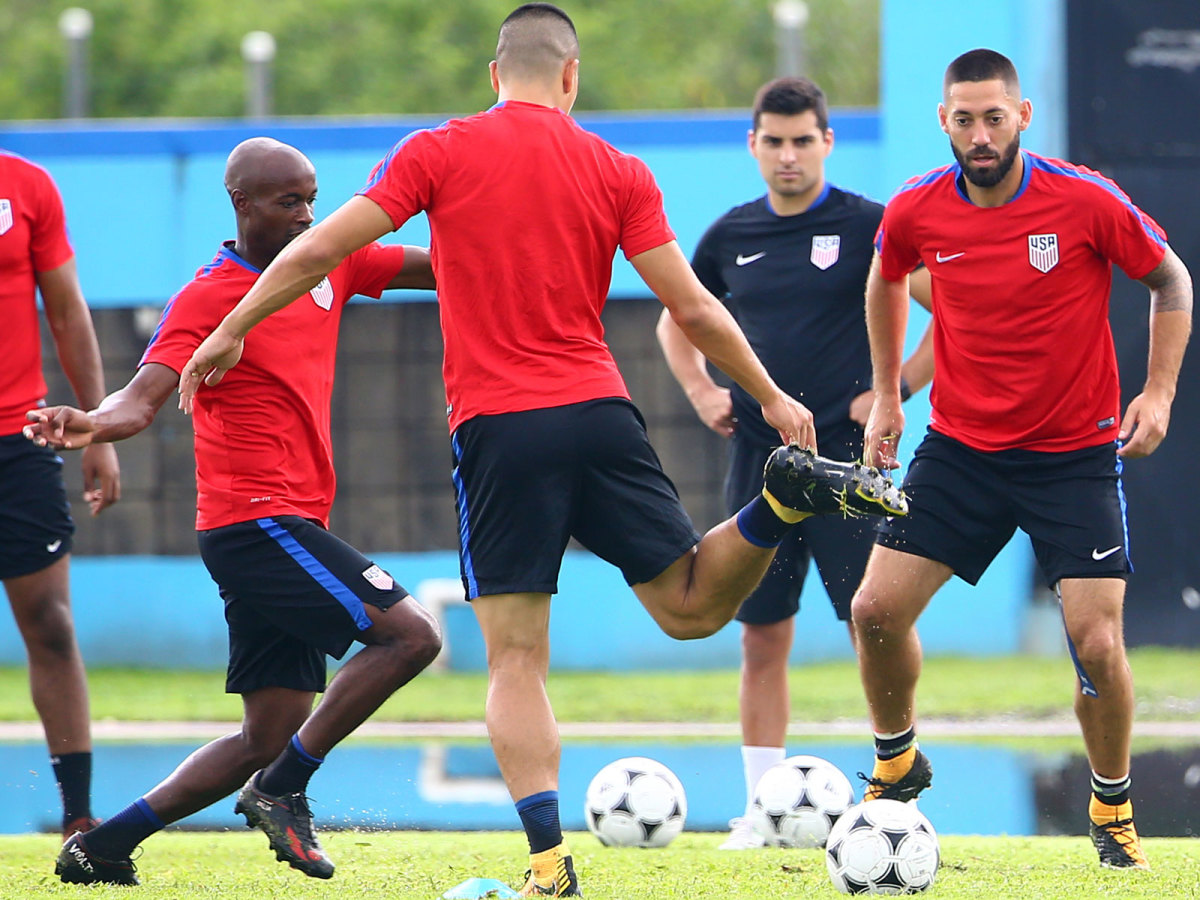USMNT Faces One Last CONCACAF Obstacle on World Cup Road in Trinidad & Tobago

PORT OF SPAIN, Trinidad and Tobago — After 23 months and 15 games, a berth in World Cup 2018 is there for the taking by the U.S. men’s national team on Tuesday night. The U.S. effectively needs only a win or a tie against last-place Trinidad and Tobago to punch a ticket for Russia. But the soccer gods make sure that little comes easy in CONCACAF, and this time that means a playing surface waterlogged by the recent downpours of the Caribbean rainy season.
The Trinis moved Tuesday’s game (as they’re allowed to) from the national stadium to Ato Boldon Stadium, a smaller structure an hour south of the capital, due to what are said to be electrical problems in the usual venue. And when the U.S. players arrived for training on Monday, they were greeted by a moat of standing water that required players to be taken on piggyback by staffers onto the field.
“It was more comedic than anything,” U.S. goalkeeper Tim Howard said.
The corners and sides of the field were under water as well. But as of Monday afternoon, U.S. Soccer president Sunil Gulati said the game was still on track for the planned kickoff at 8 p.m. ET on Tuesday (BeIN Sports, Universo).
“Right now the field is draining very well,” he said. “Our guys have just come from the match commissioner’s meeting. The game is on for 8, and if after inspecting the field tomorrow morning the field conditions are not playable, then a decision will be made. But at this point, it’s absolutely playable.”
The Recent Curse of Scoring in the USA's World Cup Berth-Clinching Game
Amusingly, a few political feathers were ruffled during the day on Monday. U.S. Soccer posted video of the piggybacking scenes on social media, and the Trinidad and Tobago federation issued a statement criticizing U.S. Soccer for it. In its release, the TTFA included a photograph of the famous SnowClásico game, in which the U.S. beat Costa Rica in a 2013 World Cup qualifier played in a Colorado blizzard.
The conditions aren’t ideal, of course, but U.S. coach Bruce Arena noted that both teams will have to play on the same field.
“It definitely changes the way the game is going to look,” Arena said. “It’s going to be a slow game, probably a little bit sloppy, a little bit different than we’ve seen in any of the qualifying games. We’ll have to adapt to the conditions on the field.”
CONCACAF qualifying is a special breed of soccer, to say the least.
“I would love to see one of these hotshot teams from Europe come here and play in our CONCACAF qualifying and really get a taste of this and see what that’s about,” Arena cracked. “This is very challenging. This is like survival of the fittest. They could do one of those TV shows on this. 'Who will survive in the end?' That’s basically what this is.”
The chances of the U.S.’s survival to reach Russia are certainly higher after Friday’s pressure-easing 4-0 victory against Panama. All three CONCACAF finales will kick off at the same time on Tuesday. U.S. captain Michael Bradley said the team would be well-aware of the scores in the other games, but he added that the U.S. has the benefit of controlling its own destiny. Win—or even tie, as long as Panama or Honduras don’t erase huge goal-difference gaps—and the U.S. is in. Nor would a loss completely eliminate the U.S., unless both Panama and Honduras were also to win.

Tuesday’s game will be a little surreal: Played in front of few home fans on a drenched field, it nevertheless is of giant importance for the United States. It isn’t a final, obviously, but the culmination of a long and grueling process makes it feel like one.
“It feels like a very big game,” said Bradley. “We’ve had to navigate so much … There’s been good moments, there’s been bad moments, there’s been moments where our backs were up against the wall. There were moments when people probably thought we weren’t qualifying. And in a real strong way, we were able to pull our group tight and make sure that none of the stuff on the outside threw us off. The reward is tomorrow night. That after 15 games we get our chance to play 90 minutes with the World Cup on the line.”
Right back DeAndre Yedlin, who had a terrific return to the U.S. lineup on Friday, said his psychology for this game was no different than the one he had for the Panama game.
“I’m trying to go in with the same mentality I had last Friday: That we needed to win,” Yedlin said. “You have to look at the situation of the game and how things are going. You know that a draw will probably do, but you never want to settle for that. If we’re not going for the win, then we shouldn’t even be on the field.”
One of the question marks for Tuesday is the status of midfielder Christian Pulisic, the U.S.’s biggest offensive threat, who came off midway through the second half on Friday after being targeted by the Panamanian defense. Pulisic was limping after the game, but he sounded optimistic on Monday.
USA Stars Point to Planning, Aggressive Approach in Curing World Cup Qualifying Woes
“It’s better,” he said. “It’s improving every single day. I’m just trying to get as much recovery now as I can … I got kicked in the calf at the end of the Panama game. But it felt good today, so we’ll see what’s going on for tomorrow.”
CONCACAF referees certainly haven’t protected Pulisic by issuing many yellow cards, and the confederation’s yellow-card suspension rules—which apply to two yellow cards in any of the 15 games going back to November 2015—mean Pulisic’s U.S. teammates have been unwilling to exact retribution (though if Jermaine Jones were around he might have decapitated someone by now).
“It’s a big problem with our sport,” Howard said on Monday. “I wish we could [retaliate]. I’m envious of hockey players and baseball players. But you can’t. There isn’t anything we could do. I wish we could because we’d lay it all on the line to protect him. You try your best to do what you can. But the onus is on the individual player in soccer to have enough wherewithal about him, both mentally and physically, and not fly off the handle and ride tackles and play the game. He’s done a good job with that.”
For his part, Pulisic said he’d been targeted since his youth soccer days with his parents on the sidelines.
“My mom would be the one to kind of yell,” he said. “My dad would just be like, ‘Get up!’ It was a good balance, I guess.”
As Pulisic sat on the bench after coming off Friday, he displayed a relatively new tattoo on the upper part of his left arm, something that caught the eye of plenty of TV viewers. The tattoo is of a giant bald eagle in front of a giant American flag.
“There’s not much of a story,” Pulisic said. “Obviously, people saw it for the first time, I guess. I like tattoos. I’m just like any other soccer player.”
If the U.S. can clinch a berth in the World Cup here on Tuesday, it’s a safe bet that viewers will see that All-American tattoo again during the postgame celebration.
